2025 LinkedIn Benchmarks
Discover the latest LinkedIn benchmarks and get insights into how to optimize your strategy to boost your LinkedIn presence.
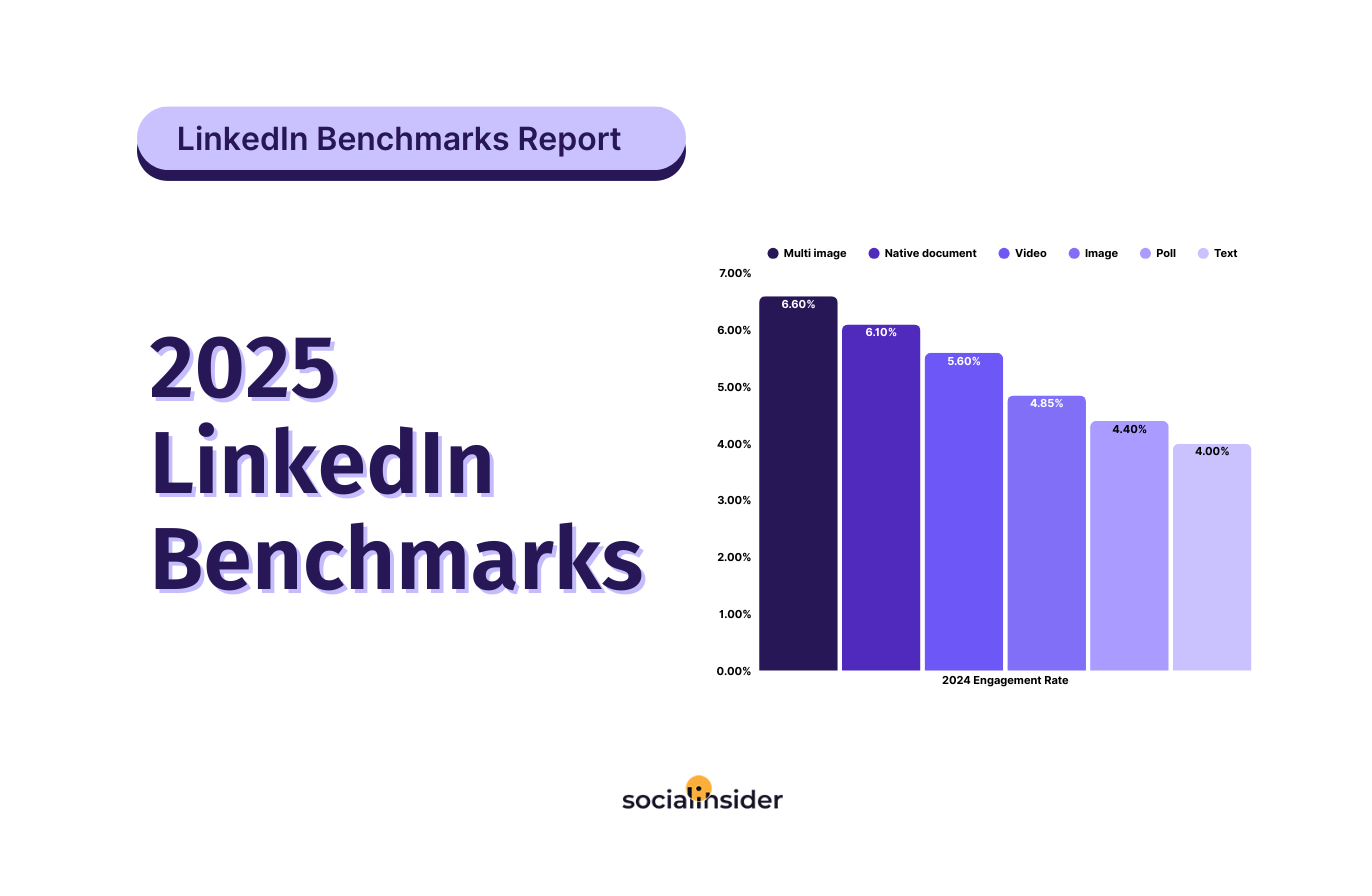
In 2025, LinkedIn isn’t just a professional network—it’s a full-scale content engine. With organic reach still very much in play and user engagement continuing to increase, brands are doubling down on the platform. But the question isn’t whether to show up on LinkedIn—it’s how to show up in a way that drives real results.
From engagement rates to video view rates, content performance to follower growth, this LinkedIn benchmarks study —based on the analysis of 1M posts published over 2024 — breaks down what’s working right now—and where there’s still untapped potential.
Executive summary
- LinkedIn engagement has decreased by 8.3% in the first half of 2025.
- By mid of 2025, LinkedIn's engagement rate by impressions stands at 5.20%.
- Multi-image posts are the most engaging type on LinkedIn, with an average engagement rate of 6.60%. Native documents follow with a 5.85% engagement rate per post, and videos have a 5.60% engagement rate per post.
- Multi-image posts is the format type that drives the highest number of likes.
- Polls generate the highest number of impressions, being a great post option for this objective.
- 32% of the brand’s posts consist of images and 30% of links.
- Brands increased their usage of videos (by 8%), polls (by 55%), and text posts (by 18%)
- Brand pages with more than 100K followers on LinkedIn can get up to 2K views per video.
2025 LinkedIn engagement trendline
Looking at engagement rates by impressions across LinkedIn, the data shows a consistent upward trend from January 2024 (4.48%) through December 2024 (5.42%), reflecting steady growth throughout last year.
In the first half of 2025, engagement peaked in March (5.76%), marking a noticeable improvement compared to the same period in 2024, when engagement averaged around 4.56%. However, starting from April 2025, engagement began to slightly decline, reaching 5.19% in June 2025.
Overall, LinkedIn engagement in H1 2025 remains higher than the previous year’s levels, despite a modest dip after March. This indicates that brands are still achieving stronger visibility and audience interaction compared to 2024, though sustaining peak performance may require a renewed focus on content formats and posting strategies.
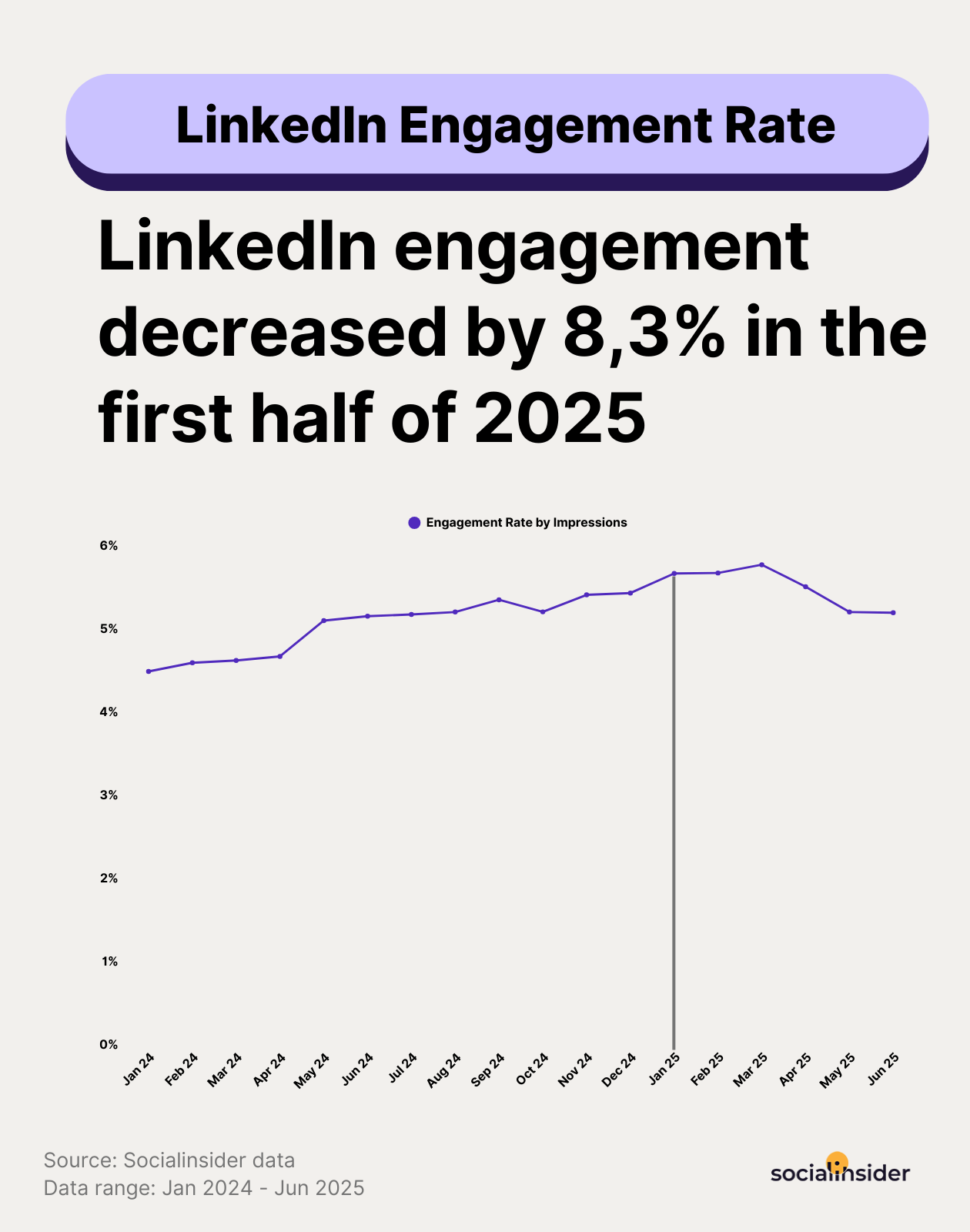
LinkedIn engagement by impressions benchmarks
Let’s get straight to the point and talk about what matters the most for every data-driven social media marketer — meaning numbers.
In 2025, multi-image posts are leading the pack with an engagement rate of 6.60% on average, which makes for the best proof that visual storytelling remains LinkedIn’s engagement sweet spot. They are the perfect format to showcase company culture and events in a quick way, which is increasingly becoming one of the must-use LinkedIn best practices for marketers in the B2B sector.
Native documents come second, with a LinkedIn average engagement by impressions of 6.10% engagement rate. Their greatest asset —being great for breaking down complex insights, step-by-step content, and frameworks that invite users to pause and engage.
Video posts now sit at a 5.60% average LinkedIn engagement rate, also scoring a significant increase — from 4.00%. This surge reflects how much the quality and relevance of native video has improved. It’s no longer about polished production—it’s about real talk, quick hits of value, and content designed to perform inside the feed.
Image posts have seen modest growth, landing at 4.85%, average engagement rate. Still reliable, still versatile—but they don’t grab attention like multi-images or video.
Polls jumped to 4.40%, doubling the engagement they generated in 2023. Pretty huge, isn’t it? When done right—meaning with real, opinion-sparking questions—polls are no longer just reach plays. They’re earning meaningful engagement and driving visibility in a major way.
Text-only posts hovered around 4%, slightly up from 3% 2023’s engagement values. They can still work, but only when the writing is sharp, bold, or deeply personal.
Overall, the post formats that saw the most significant engagement increase compared with the previous year were:
- Native documents
- Videos
- Polls
- Text posts
What this LinkedIn data tells us is simple: format matters more than ever. The type of content you post directly impacts how much traction you get.
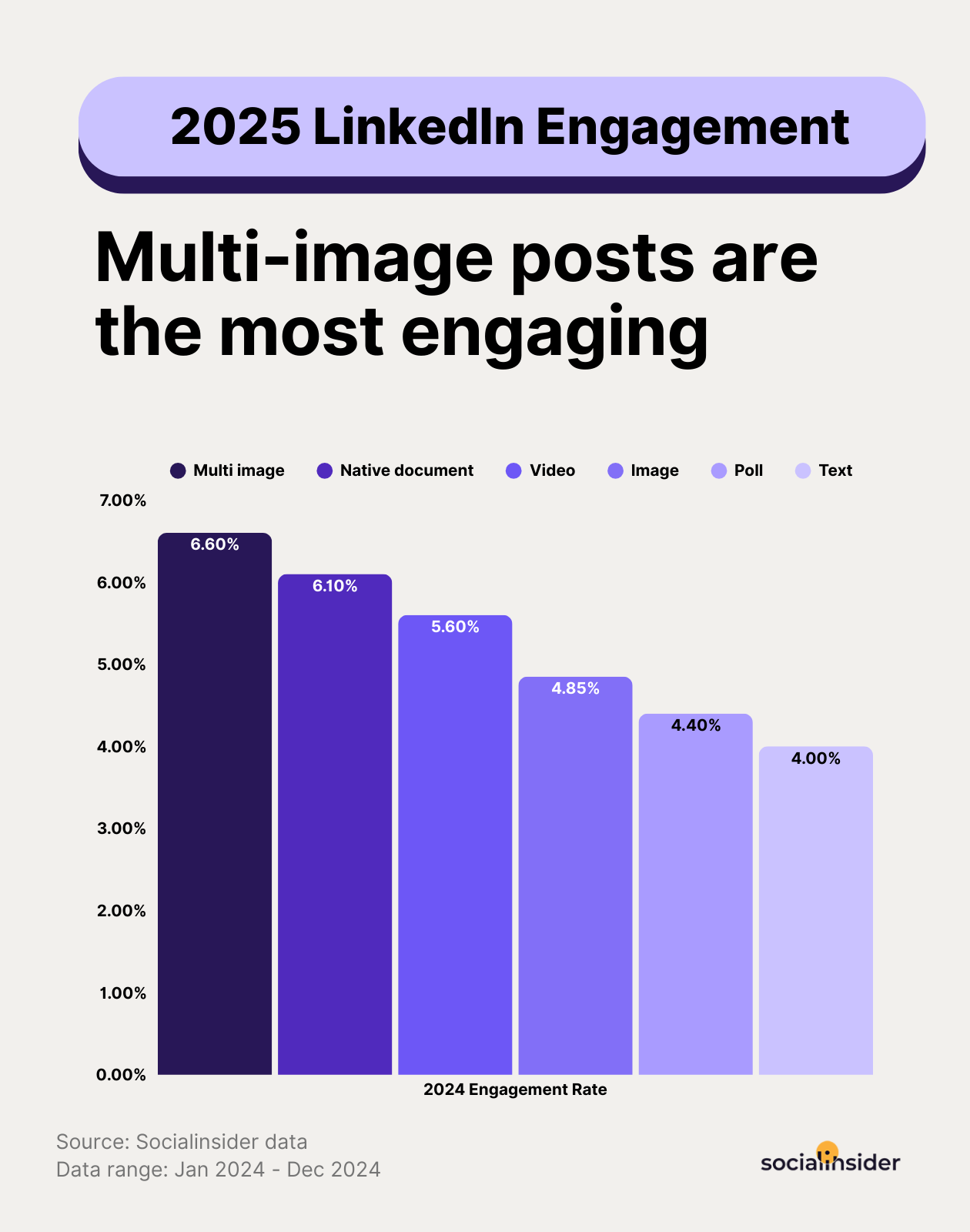
Strategic tactics on how to improve your LinkedIn engagement rate
- Prioritize multi-image posts and native carousels. These formats give you real estate to tell a story, break down concepts, or showcase step-by-step value. They naturally encourage swipes, which signals engagement to the algorithm.
- Start using native video—strategically. Don’t just post a video because it looks good. Give it a hook in the first 3 seconds. Add subtitles. Keep it under 90 seconds. Videos have the third-highest LinkedIn average engagement rate in 2025 and are the most shared format—so if you're not using video, you're leaving reach on the table.
- Don’t neglect polls—but use them with purpose. Generic questions won’t cut it anymore. Frame polls around hot takes, trends, or internal industry debates. They’re not just for impressions anymore—they’re earning real engagement and a great instrument for research.
- Stop over-relying on link posts. They’re still common, but their average LinkedIn engagement rate is dragging behind. Instead, repurpose blog content into carousel posts or short-form videos that lead users to the link in the comments.
- Mix post types strategically. The most successful brands are not limited to a single format. They use multi-image and video as anchors and sprinkle in polls and carousels to mix up engagement styles throughout the month.
Increasing your brand presence in 2025 on Linkedin will come down to having a more authentic, human approach to using the platform. Sharing stories and experiences rather than faceless graphics, stats and conference updates and creating deeper and more genuine connections with your audience. - Katie Brown, Founder at Five Social UK
LinkedIn’s average likes per post
When it comes to likes, follower count isn’t just a vanity metric—it’s a multiplier. The more followers you have, the harder your content can hit. But here’s the nuance: not all formats are created equal when it comes to earning those likes.
Multi-image posts lead the pack when it comes generating instant appeal. That makes them the most “likable” format on LinkedIn right now. This format excels because it invites scrolling, tells a visual story, and often delivers bite-sized value across each frame—perfect for engaging B2B audiences who want to learn without reading a wall of text.
Single image posts rank second when it comes to the number of likes generated. This content type has proven to be very successful at catching the viewer’s attention especially when paired with bold visuals, branded design, or attention-grabbing stats. They’re quick to consume and easy to like, which keeps them high in the engagement funnel.
Videos are not very far behind, clearly resonating with LinkedIn’s audience—especially when it feels personal, direct, and high-value.
Native document carousels (PDF-style posts) also continue to perform well, especially when the content is practical and instantly useful—think checklists, templates, or quick frameworks.
Thoughtful comments from the brand build credibility, while ambassadors (including leaders!) expand its reach, boost trust, and draw visitors to the company’s profile. That strong foundation then helps turn visitors into community members. - Mihaela Radu, LinkedIn Strategist
And while the numbers vary across the board, this trend isn’t just at the top. The pattern repeats itself across all page sizes.
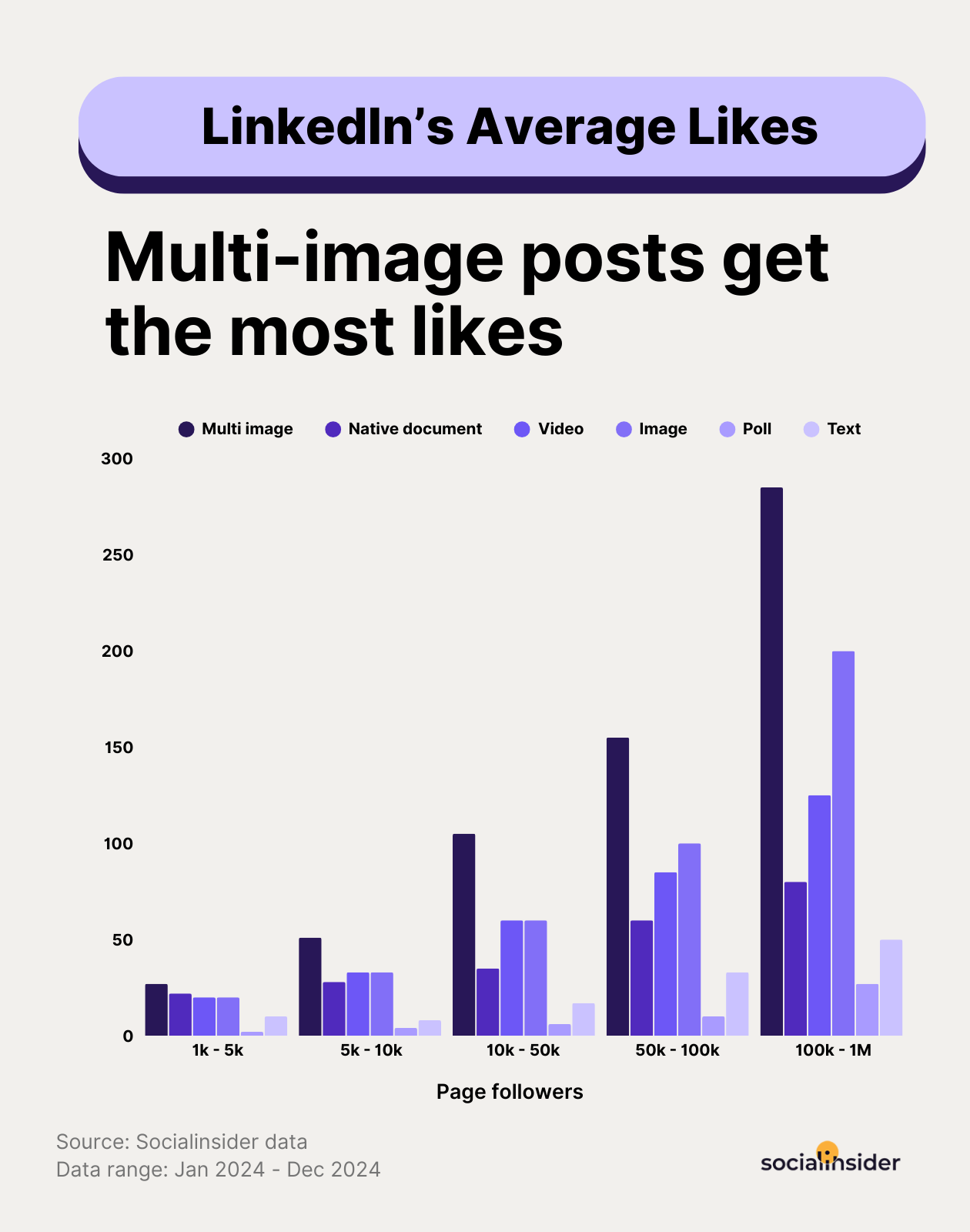
Strategic tactics to boost your likes on LinkedIn
- Build out multi-image storytelling. Introduce a problem, tease the insight, then deliver the punch.
- Pair strong captions with scrollable content. Don’t just upload images—contextualize them. A compelling hook in the caption boosts click-through into the image gallery, which increases the chance of a like.
- Make videos native, short, and human. While video likes trail multi-images, they still punch above their weight, especially if you hook viewers fast and keep it under 90 seconds. Behind-the-scenes, founder clips, and quick tips are all formats that perform.
- Push engagement in the first hour. LinkedIn’s algorithm loves early traction. Encourage your internal team to like and interact with posts when they go live. That quick momentum can snowball your reach.
Stop feeling above crafting a well-rounded social strategy. B2C brands often get the reputation of being able to have the most fun, but B2B brands can also partake. It takes figuring out your community and how you can best engage them. If there is a trend happening that makes sense for your brand, create content around that. If there is a meme that is relatable to your brand and community, post that! Jada S, Senior Social Media Manager
LinkedIn’s average impressions per post
In 2025, polls dominate when it comes to impressions on LinkedIn. No other format even comes close.
Polls consistently generate more impressions than any other type of post—and it’s not hard to see why. They’re frictionless to engage with, and every vote sends that post right back into the voter’s network, creating a viral feedback loop of visibility.
When framed around hot takes, trending topics, or light controversy, they become algorithmic magnets. Polls are lightweight to engage with but heavyweight when it comes to reach.
On the other end of the spectrum, text posts are the weakest link in terms of impressions.
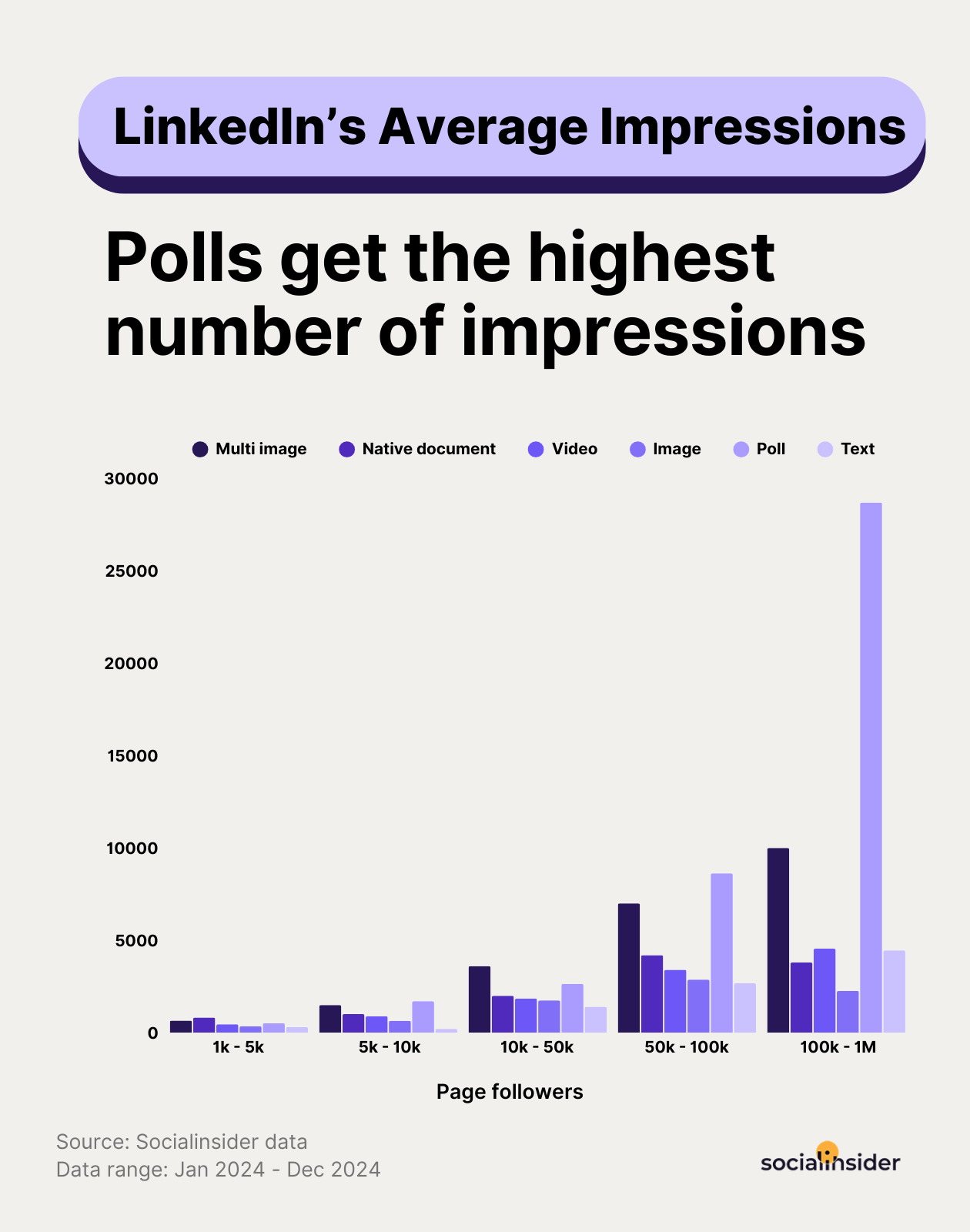
Strategic tactics to boost your impressions on LinkedIn
- Use polls strategically (but don’t abuse them). Yes, they’re impression magnets. But that only works if they ask real questions. Think industry trends, controversial opinions, social media research or light-but-relevant takes.
- Use the caption to set the stage. A great poll isn’t just about the question—it’s about the context. Use the caption to share a quick insight, drop a stat, or challenge a norm. Then ask for the vote. Treat it like a micro-thought leadership post with a call to action baked in.
- Ditch plain text posts unless you plan on saying is truly valuable. If you’re going text-only, go bold. Share a strong opinion, an emotional moment, or a surprising insight. Otherwise, it’s just noise—and the algorithm knows it.
Brands can't afford to 'wing' socials anymore. They need to examine their holistic strategy, values, and how consumers interact with them to make sure they aren't drowning in a sea of noise. Chasing virality isn't a goal anymore; consumers expect to be prioritised and brands need to focus on connecting with them at a deeper level. - Magali Mas D’Amato, Social Media Consultant
LinkedIn’s average views per video
When we look at video views on LinkedIn, the gap between the smallest and largest company pages is more than just noticeable—it’s massive.
Pages with less than 5K followers gain on average 190 views per video. While that may not be an incredible,huge number, that's expected. These pages are still building brand awareness, have limited reach, and are often just beginning to experiment with video content.
Pages with more than 100K followers are getting on average 2.4K views per video. These pages are capitalizing on experience, refined strategy, and algorithmic momentum to drive serious video visibility.
However, keep in mind that the page size alone doesn’t guarantee viewership. Format, style, and content quality play an important role as well.
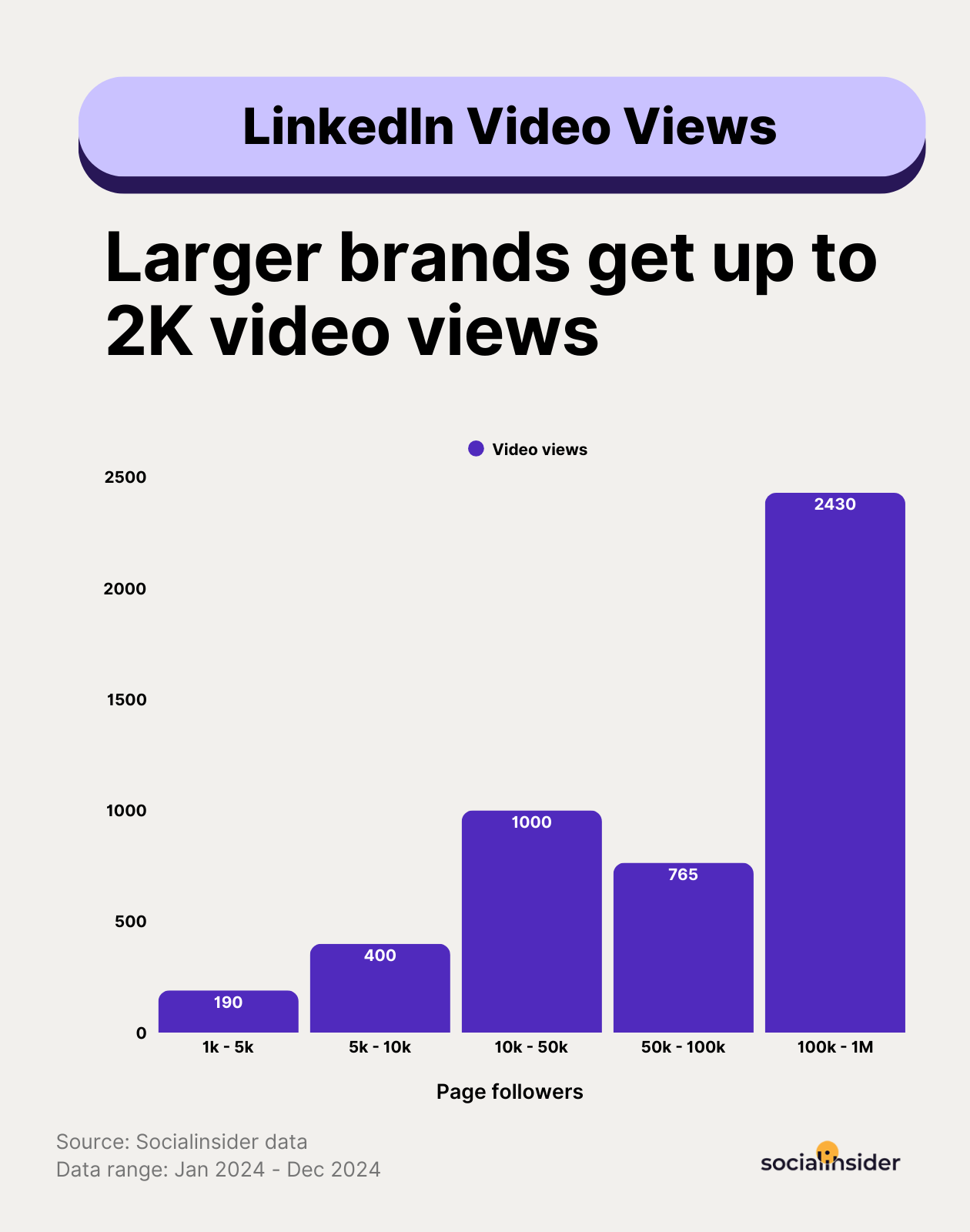
Strategic tactics to boost your video views on LinkedIn
- Start with the hook—always. If your first three seconds don’t stop the scroll, you’ve already lost. Open with a bold question, a surprising stat, or a direct statement. That’s how you make people pay attention.
- Make it personal, not promotional. People don’t share or watch ads—they engage with stories, lessons, and insights. Shift from “Here’s our product” to “Here’s what we learned launching our product.” Shift from pitch to perspective.
- Go short, sharp, and real. Forget long intros or fancy transitions. Keep it under 60 seconds. Use captions. Speak directly to the camera.
- Bring your C-level on LinkedIn. Whether it’s your founder, your head of content, or brand advocates—human faces drive more engagement and watch time than logos, motion graphics, or stock footage. People connect with people.
In 2025, B2B brands can increase their brand presence by focusing more on thought leadership content. This can be through video content whether short vertical video content or long video content. While at it brands need to be consistent, be authentic and focus on content that is engaging and adds value. Egline Samoei, Digital Marketing Strategist
Posting patterns
In 2025, company pages on LinkedIn are publishing more than ever, which shows they are no longer treating LinkedIn as an afterthought.
But here’s where it gets interesting: while brands are showing up more often, most of that content is still concentrated in just two formats.
When it comes to content divisation, here’s how brands orient their efforts: 30% of their published content represents images, while 28% consists of link posts.
The high share of image and link posts shows that many brands are leaning into formats that are quick to produce and easy to schedule. It’s an efficient way to maintain a regular posting rhythm—but it also highlights an opportunity.
Blending consistency with a more diverse content mix can help ensure that increased volume actually translates into stronger engagement and better visibility.
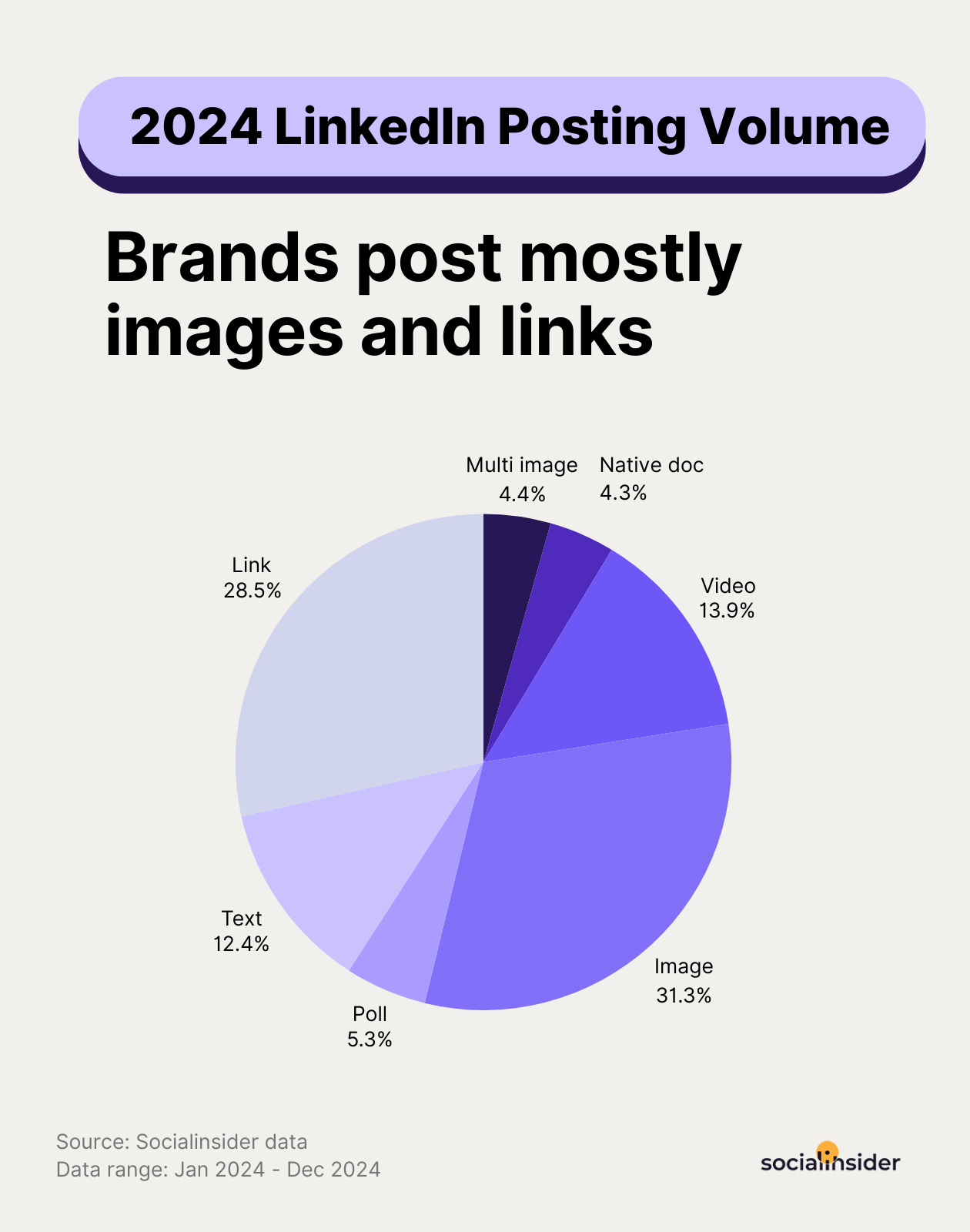
However, when analyzing brand’s posting patterns YoY we did see some changes—and in a good direction.
Compared to 2023, brands have increased their usage for the following formats, taking the first step toward a more diversified content calendar:
- Videos scored an 8% increase in usage. It might not be much, but it’s a start, given the increased effort it takes to create videos compared to other post formats.
- Polls have seen a 55% increase in usage. That’s something quite remarkable. A year ago, polls were more passive: users would vote, and that was it. But now, brands are crafting polls that prompt opinions, spark debate, or tie into trending industry topics.
- Text posts gained an 18% increase in usage. When used wisely - meaning for sharing a strong opinion, an emotional moment, or a surprising insight - they can get pretty effective.
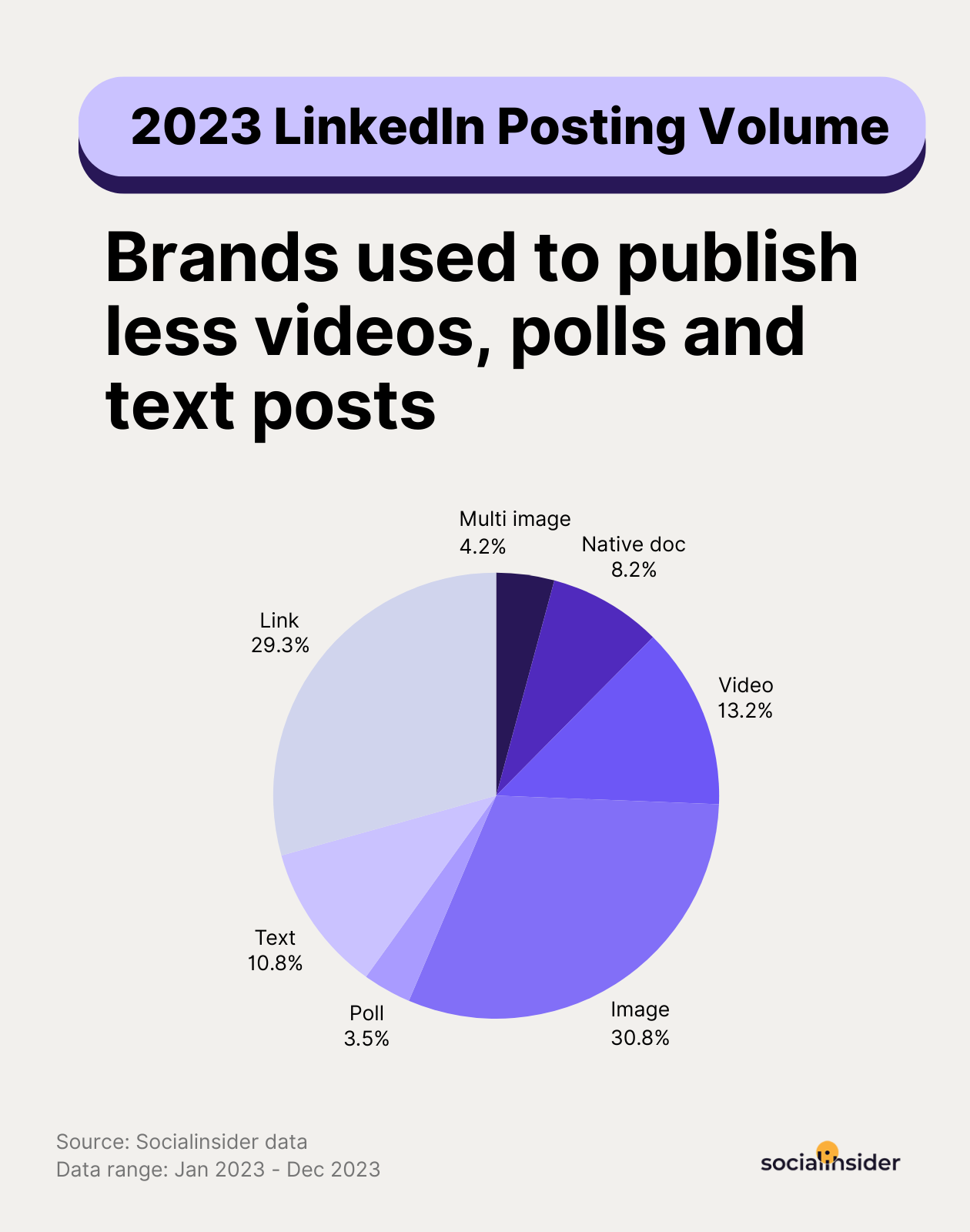
Strategic tactics to improve performance on LinkedIn
- Turn one idea into multiple formats. Instead of creating 15 separate ideas, start with 4–5 strong insights and repurpose each one. Turn a blog post into a carousel, a short video, a poll, and a mini image quote. This way, you scale output without burning out on ideation.
- Balance quick wins with high performers. Image and link posts are fast, but should be used as supporting content—not the foundation. Anchor your calendar with formats that drive strong engagement, then use lighter formats to fill gaps or amplify key messages.
Remember that employees with strong personal brands are an asset and not a liability. Allow them to be advocates for your brand in a way that is honest, human, and authentic. Don't simply give them canned corporate language to cut and paste on LinkedIn, but allow them to share their honest thoughts and insights into your industry. Jon-Stephen Stansel, Social Media Consultant
Posting distribution
Now that we’ve seen how brands are segmenting their LinkedIn content strategy, let’s take a peek at how this translates into the actual number of posts published on LinkedIn.
- Multi-image: 1 post per month
- Native document: 1 post per month
- Video: 2 posts per month
- Image: 5 posts per month
- Poll: 1 post per month
- Text: 2 posts per month
- Link: 4 posts per month
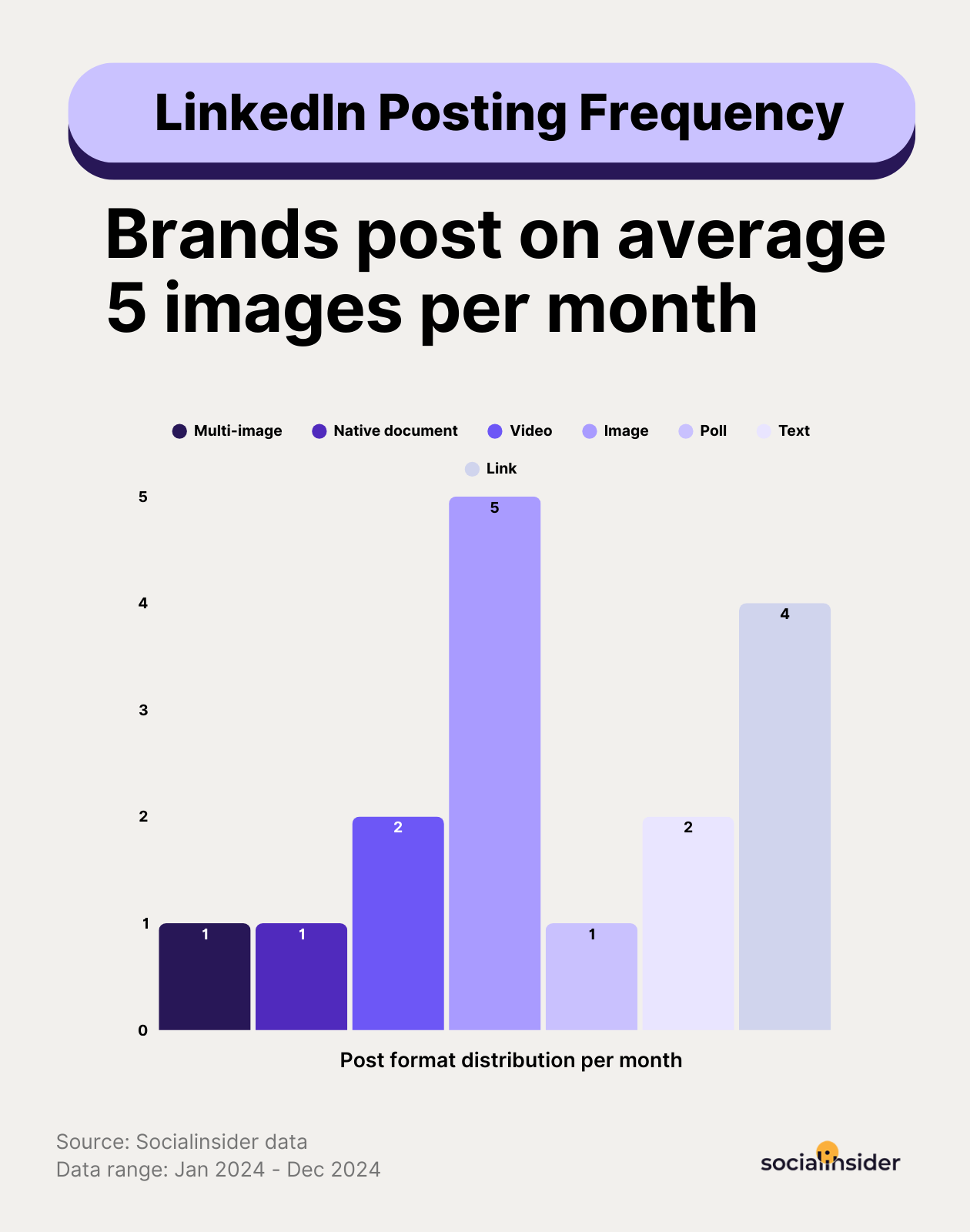
Strategic tactics to improve performance on LinkedIn
- Use analytics to shape your cadence. Look at your performance per format, not just per post. For example, if video consistently outperforms but you only post it once a month—scale it up.
- Shift one image post per week into a high-performing format. Replace a standard image or link post with a multi-image or native document.. Even small changes in format mix can create major lifts in impressions and engagement.
For successful LinkedIn marketing I recommend Influencer partnership sponsored posts boosted by company thought leadership ads - this is a very effective way to leverage the organic reach and clout of a popular thought leader in your niche to forward your brand image, at the same time. - Emilia Korczynska, VP of Marketing at Userpilot, co-founder at ZenABM
Followers' growth rate benchmarks
Now, we’ve arrived at the last chapter of our LinkedIn benchmarks analysis. Let’s see the insights data unpacked when it comes to growing a presence on LinkedIn.
Pages with 1K–5K followers increased their audiences by over 40% year-over-year, growing their follower base at a much faster rate than larger ones.
As brands grow beyond the 10K mark, the growth rate begins to cool.
Pages between 10K and 50K followers are seeing more modest—but steady—expansion, while 100K+ pages experience the slowest follower growth of all.
Smaller brands are in the best position to grow fast, but every tier presents its own challenge. Early growth is about visibility. Mid-tier growth is about consistency. And at scale? It’s all about brand relevance and retention.
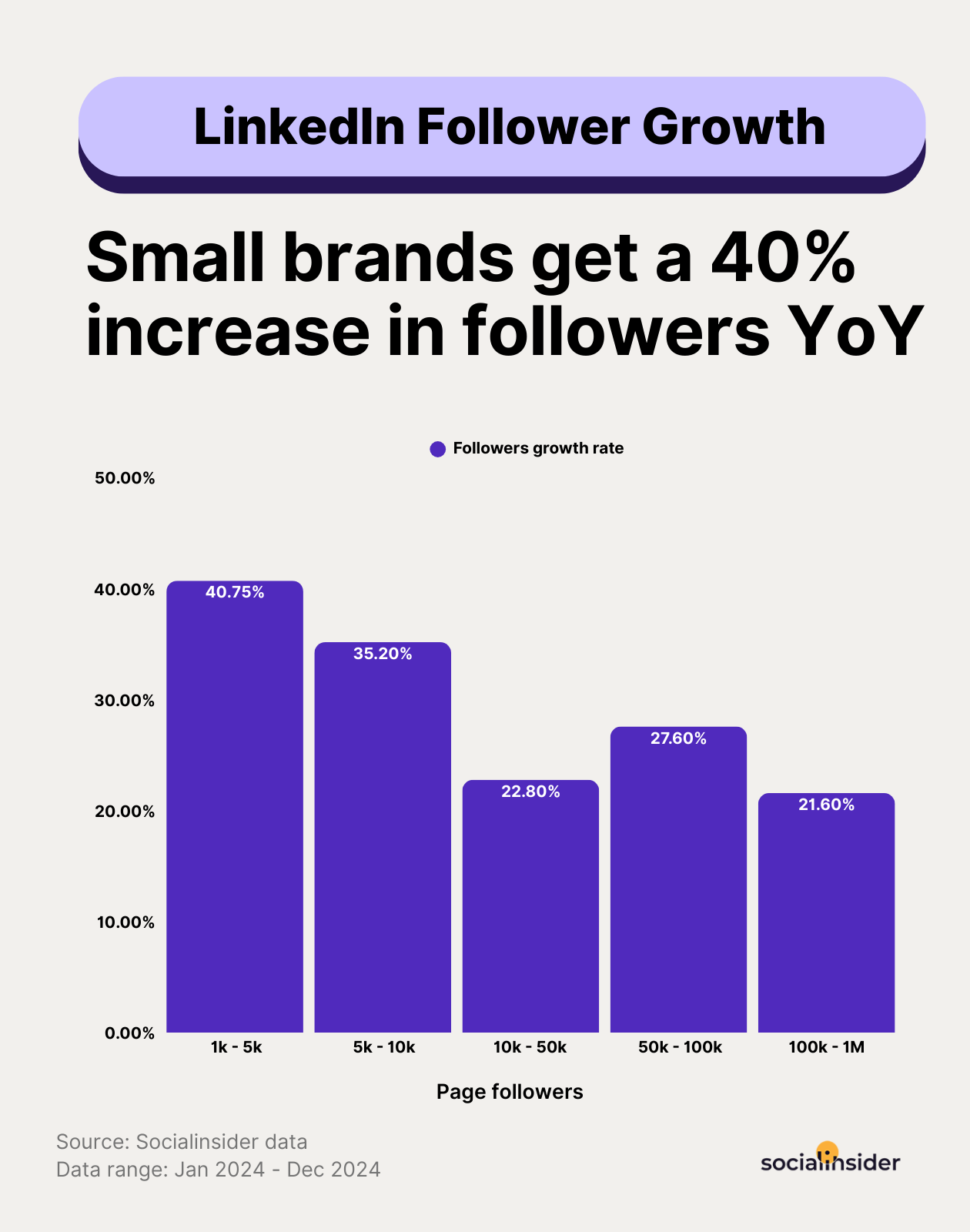
Strategic tactics to increase your follower base on LinkedIn
- Use high-impression formats to feed discovery. Remember how successful polls are in generating impressions and how videos increase shareability? Well, that’s a great starting point for you. The more people see your content, the more likely they are to follow your page. Lead with formats that get traction, and make sure your brand story is clearly represented in every post.
- Create a shareable brand voice. The pages that grow fastest aren’t just informative—they’re distinctive. Having a clear tone makes your content more memorable—and more followable.
- Highlight employees as content creators. Encourage your team—especially leadership and subject matter experts—to create original content and tag the company page. Their networks are often untapped gold mines for brand visibility. The more you activate internal voices, the more organic discovery happens.
In 2025, more so than at any other time, the value of human connection is high. By empowering their teams to use LinkedIn effectively, brands will see a huge uplift in their brand presence on LinkedIn. If brands want to really take their marketing seriously – and maximise their marketing budgets, they need to be supporting and training their employees to go out on LinkedIn as their ambassadors from their personal profiles. - Sarah Clay, Corporate LinkedIn Trainer
Methodology
The findings of this study were based on the analysis of 1M LinkedIn posts, collected from 9K LinkedIn business pages with an active presence between January 2024 - December 2024.
The content formats references in this analysis consist of the following:
- Native documents: the type of post consisting of a PDF uploaded directly on LinkedIn that is similar to a carousel.
- Multi images: the upload of multiple photos at once, displayed similarly to an album.
- Text posts: LinkedIn posts consisting of a block of text.
- Polls: open for voting questions.
- Image: posts that include the upload of an image.
- Post shares: shares of other people’s/ company’s posts that were posted within the platform.
- Video: posts that include the upload of a video.
We define LinkedIn metrics as follows:
- Engagement rate by impressions: how many people interacted with your LinkedIn posts from those who watched repeatedly. It is calculated by dividing your engagement by impressions, then multiplied by 100. This is the same formula LinkedIn uses.
- Average impressions per post represents the number of impressions a post receives on average.
- Average views per video stands for the average number of views a video gets, on average.
- Average number of posts per month: how many posts pages post on average on LinkedIn
Analyze your competitors in seconds
Track & analyze your competitors and get top social media metrics and more!
Ready to improve your social media strategy with real-time insights?
Get strategic insights, analyze the social performance across all channels, compare metrics from different periods and download reports in seconds.